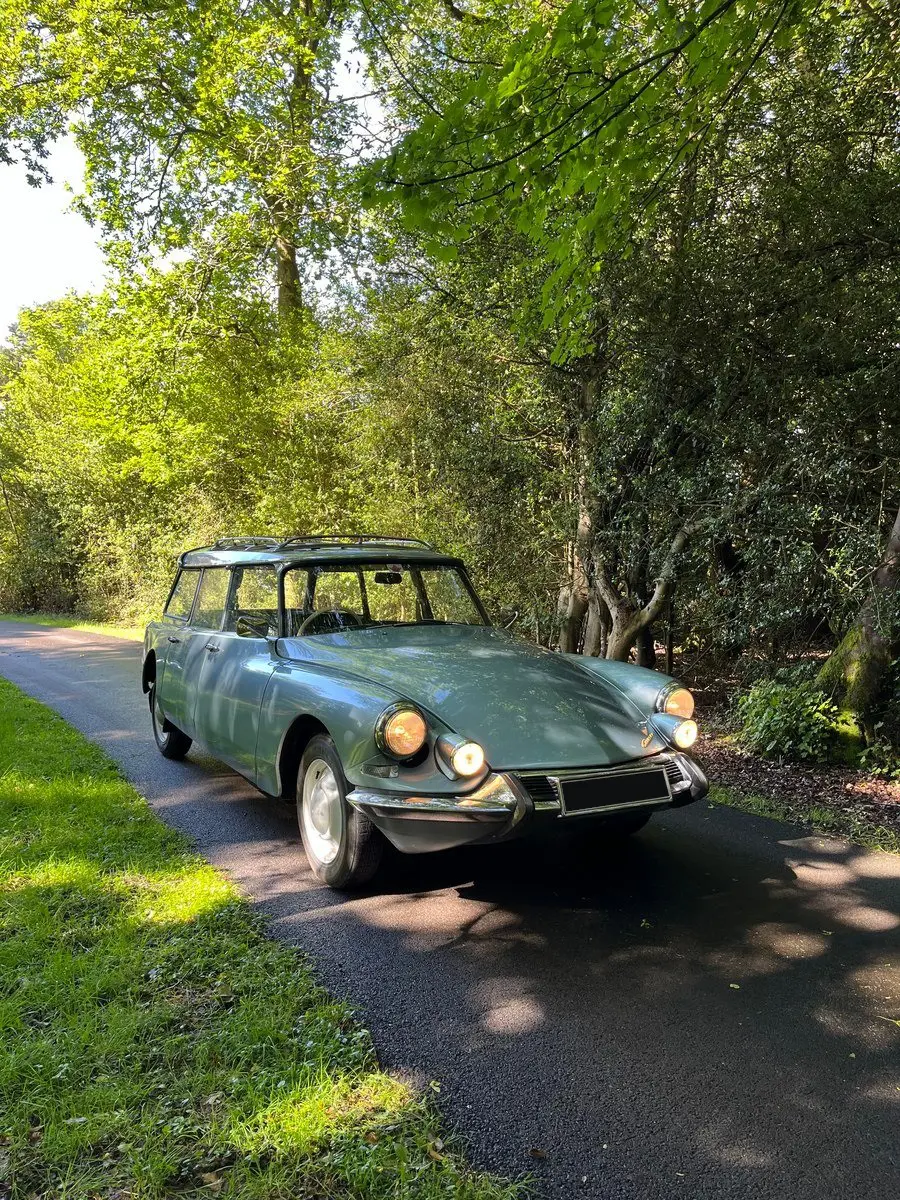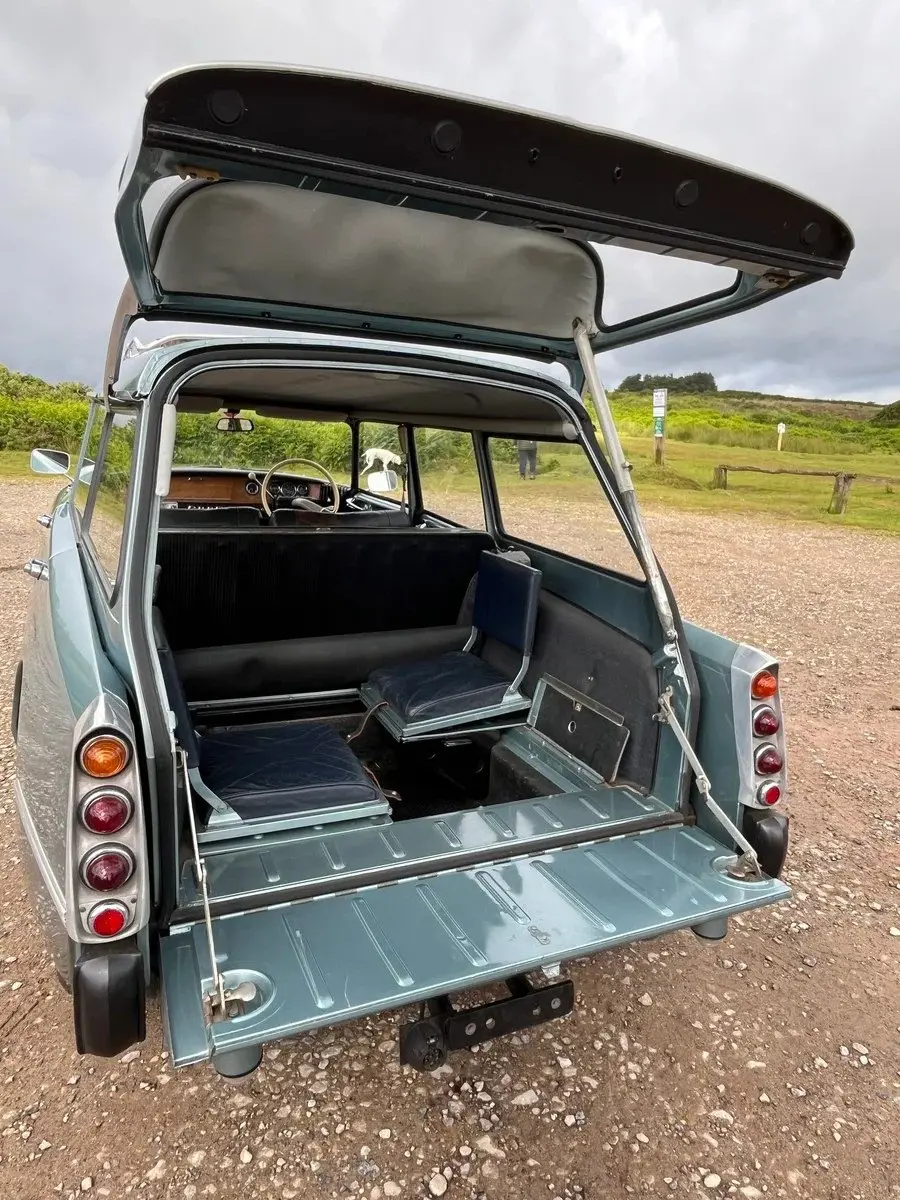RARER THAN RARE – 1964 SLOUGH-BUILT CITROEN SAFARI
19 September 2024
No matter how blasé you might regard yourself about classic cars, a 1964 Citroën Safari in its “Metallichrome” Silver Blue glory still has the power to turn heads. Not to mention the fact that Paul Darvill’s example must be one of the most thrilling products to ever hail from Slough, not excluding Stingray, Thunderbirds and Captain Scarlet.

Citroën made a range of products at the home counties plant between 1926 and 1966 to circumvent UK import duties. The plant covered four acres, and a 1961 brochure stated the cars were “assembled with components, mostly British, selected to meet British tastes and to answer British requirements”. By 1965, Slough had stopped complete assembly from CKD kits and continued to paint and trim the D-series range until February 1966. These were the sole UK-market Citroën cars at that time; the Slough-built 2CV ran from only 1953 to 1959, sales of the Deux Chevaux-based Bijou ended in 1964, and there was never a British-built Ami 6.
There are many details on Paul’s Safari that distinguish it from a French-built model: the hide trim, the (slightly incongruous-looking) walnut-veneered dashboard, the reversing lamps and the Lucas 12-volt electrical system. Such features were not only an attempt to appeal to James Robertson Justice-style landowners, as the Slough D-series required a minimum of 50% local content for the government to classify it as a domestic product. Paul observes that his Safari also sports the optional front Marchal auxiliary lights. He further notes the Slough version has a body-coloured chassis – “very stylish” – and a front bumper designed to accommodate a UK number plate.
The DS model hierarchy can be highly confusing at first sight – think the last episode of The Prisoner in terms of complexity. Put simply, Citroën introduced the Safari estate version in 1958, with the manual, four-speed gearbox and less powerful engine of the ID. Five years later, Slough introduced an improved Safari with the DS engine, giving a top speed of over 95 mph, and power-assisted steering. The Motor thought it was “possibly the most spacious and luxurious European estate car”, and here is my impression of another 1964 model I drove for Classic & Sports Car:

Starting the Citroën was an experience that one can never become blasé about; the sensation of over 16ft. of car slowly rising, wheel by wheel, to the accompaniment of hydraulic groans is still impressive regardless of how many times you experience it.
Driving that Slough Safari along the roads of a former rocket-testing base was a wonderfully surreal experience, akin to a mid-1960s edition of The Avengers. A big Citroën was the perfect car for this week’s guest supervillain, who Steed and Mrs. Peel must defeat in his bid to rule the world. After nine years I have still not forgotten the rubber “mushroom” that operated the power-assisted brakes – I wrote in my report they were “so sensitive that the slightest touch can make an imposing motor car stop on a 6d piece”. Above all:
There is a complete absence of an imprecise column shift, lumbering handling that made roundabouts a challenging prospect and an unyielding ride – all elements that would have been very familiar to well-heeled British motorists of that time. But anyone who was used to a big Humber, Vauxhall or Ford would be incredulous as to the Citroën's lack of wallowing, and even when travelling along roads worn down by years of heavily laden military Bedfords, there was always the sensation of the Safari actually gliding along.
Fewer than 300 Safaris departed Slough before Citroën GB decided to entirely import the DS family. Fear of its complexity was almost certainly one reason for its limited sales, and another challenge was, to quote one former Slough employee, that the company “saw no need for dealer training”. Then there was the Safari’s price. Sixty years ago, it cost £1,698 5s 5d, when an Abbot-bodied Ford Zodiac Mk. III Estate was £1,261, a Vauxhall Cresta PB with Martin Walter coachwork was £1,306 and a Humber Super Snipe Estate was £1,565.
Anyone sufficiently broadminded to have considered purchasing a Citroën in 1964 might have considered a Fiat 2300 Familiare or a Volvo Amazon Estate. Still, even these cost £1,424 and £1,227, respectively. However, the proud Safari owner could boast it was the sole UK-built, front-wheel-drive large estate. It was also a remarkably practical machine, from the adjustable ride height and integral roof rack to the two folding seats in the luggage compartment and the double rear number plate, so the driver could pilot it with the tailgate open. Citroën even thoughtfully provided a starting handle in case your Safari failed to proceed, a device Paul has never used.
Paul has owned his Citroën for three years and is parting with it as he is now Paris-based: “I am looking for a LHD classic car, preferably a Lancia Fulvia Coupe.” As for the Safari’s history, Mr C. R. Freund, a director of Parkfield Ltd., ordered it from Frank Dell Ltd. of Chalfont St Peter, Buckinghamshire. As Parkfield designed and manufactured film industry equipment, Paul wonders if his Safari once served as a camera car – a not uncommon role for D-series estates – and has greatly enjoyed being the Safari’s custodian: “Yes, I have carried seven people in it! One challenge to Citroën ownership was that I was afraid to touch anything, due to its complexity! But it is a remarkable machine, from the inboard front brakes to its hydraulic suspension.”
Or, as one dealer urged: “See Today The Car Of Tomorrow.”
With thanks to Paul Darvill for his time and permission to use the images in this blog.
